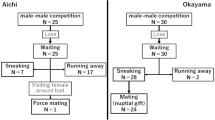Abstract
Using data from 23 populations of Indian langurs (Presbytis entellus), we show that the proportion of one-male groups is a function of the males’ ability to defend groups of females, as predicted by the monopolisation model of Emlen and Oring (1977). However, we show that in addition to the number of females in the group and their reproductive synchrony, home range size is also a factor, probably because it affects a male’s willingness to search for other groups. These variables in turn are shown to be functions of environmental parameters (rainfall volume and seasonality, and mean ambient temperature) which probably act via the density of resources and refuges in habitats.
Similar content being viewed by others
Author information
Authors and Affiliations
Additional information
Received: 3 March 1994 / Accepted after revision: 24 June 1996
Rights and permissions
About this article
Cite this article
Srivastava, A., Dunbar, R. The mating system of Hanuman langurs: a problem in optimal foraging. Behav Ecol Sociobiol 39, 219–226 (1996). https://doi.org/10.1007/s002650050284
Issue Date:
DOI: https://doi.org/10.1007/s002650050284



